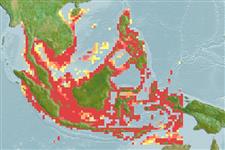Common names from other countries
Environment: milieu / climate zone / depth range / distribution range
Ecologie
marien rifbewoner; diepte 5 - 50 m (Ref. 90102). Tropical; 20°N - 12°S, 97°E - 135°E (Ref. 3810)
Western Central Pacific: Philippines, South China Sea, Singapore, and Indonesia.
Grootte / Gewicht / Leeftijd
Maturity: Lm ? range ? - ? cm
Max length : 18.0 cm SL mannelijk / geslacht onbekend; (Ref. 48635); common length : 15.0 cm SL mannelijk / geslacht onbekend; (Ref. 3810)
Dorsale stekels (totaal): 10; Dorsale zachte stralen (totaal): 9; Anale stekels 3; Anale zachte stralen: 7. Head scales reaching forward to between level of anterior margin of eyes and posterior nostrils. Suborbital naked. Lower limb of preopercle naked. Pelvic fins short, not reaching level of anus. Axillary scale present. Color: Pale brownish on back, lower part of body whitish. Presence of two bluish stripes across snout, first from middle of eye to tip of snout, second from upper lip to lower margin of eye. Top of snout dusky.
Found in silty coastal bays to deep muddy habitats offshore. Swims on open substrate adjacent to reefs, usually in small aggregations. Often with large bottom feeders such as stingrays to catch disturbed prey (Ref. 48635). Juveniles found close to reefs. Feeds on small crustaceans. Also taken by bamboo stake trap in Thailand. Used also in fish balls, fried and as duck food. Not much appreciated for food, and low priced.
Levenscyclus en paargedrag
Maturiteit | Voortplanting | Paaien | Eieren | Fecunditeit | Larven
Russell, B.C., 1990. FAO Species Catalogue. Vol. 12. Nemipterid fishes of the world. (Threadfin breams, whiptail breams, monocle breams, dwarf monocle breams, and coral breams). Family Nemipteridae. An annotated and illustrated catalogue of nemipterid species known to date. FAO Fish. Synop. 125(12):149p. Rome: FAO. (Ref. 3810)
Status op de Rode Lijst van het IUCN (Ref. 130435)
CITES (Ref. 128078)
Not Evaluated
Gevaar voor de mens
Harmless
Gebruik door de mens
Visserij: van minder commercieel belang
Meer informatie
Lokale namenSynoniemenMetabolismePredatorenEcotoxicologieVoortplantingMaturiteitPaaienFecunditeitEierenOntwikkeling van de eieren
ReferentiesAquacultuurAquacultuurprofielKweeklijnenGeneticaElectrophoresesErfelijkheidZiektesVerwerkingMassaconversie
Tools
Speciale rapporten
Download XML
Internetbronnen
Estimates based on models
Preferred temperature (Ref.
115969): 27.7 - 29.2, mean 28.7 (based on 588 cells).
Fylogenetische diversiteitsindex (Ref.
82804): PD
50 = 0.5002 [Uniqueness, from 0.5 = low to 2.0 = high].
Bayesian length-weight: a=0.01349 (0.00767 - 0.02371), b=2.98 (2.83 - 3.13), in cm Total Length, based on LWR estimates for this species & (Sub)family-body (Ref.
93245).
Trofisch niveau (Ref.
69278): 3.5 ±0.50 se; based on food items.
Weerstandsvermogen (Ref.
120179): Hoog, minimale populatieverdubbelingstijd minder dan 15 maanden (Preliminary K or Fecundity.).
Fishing Vulnerability (Ref.
59153): Low vulnerability (12 of 100).
